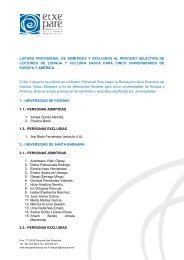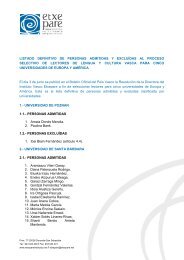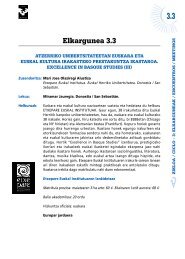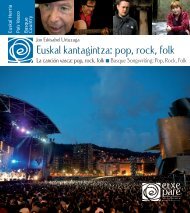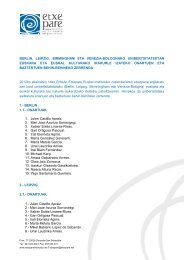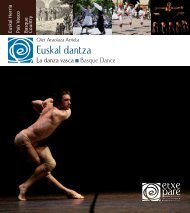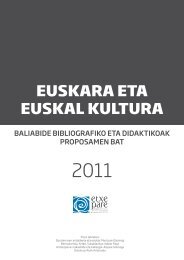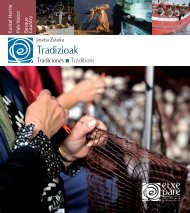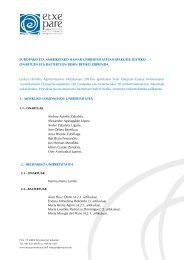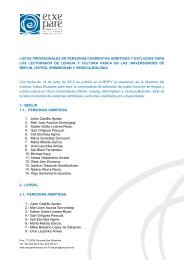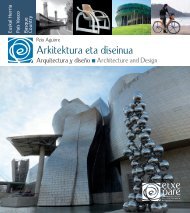XX. mendeko euskal literatura - Etxepare, Euskal Institutua
XX. mendeko euskal literatura - Etxepare, Euskal Institutua
XX. mendeko euskal literatura - Etxepare, Euskal Institutua
Create successful ePaper yourself
Turn your PDF publications into a flip-book with our unique Google optimized e-Paper software.
Martín Ugalde (1921-2004) supo explicar mejor que<br />
nadie el efecto devastador que la represión política<br />
y el exilio tuvieron en muchos ciudadanos vascos.<br />
El propio autor tuvo que hacer frente a tres exilios.<br />
Entre las obras de Ugalde son de destacar el libro de<br />
narraciones Illtzalleak (1961) que refleja la dureza de<br />
la guerra y la posguerra, así como las novelas Itzulera<br />
baten istorioa (1989) y Pedrotxo (1993). La primera<br />
muestra los esfuerzos inútiles de una familia vasca<br />
por regresar al País Vasco; la segunda analiza la destrucción<br />
humana causada por la guerra y la represión<br />
franquista de la posguerra.<br />
Tras la guerra, la primera novela en ver la luz en el<br />
País Vasco peninsular fue Alos-Torrea (1950) de Jon<br />
Etxaide (1920-1998), basada en la leyenda “Gau-illa”<br />
de Juan Venancio Aranquistain. Al mismo autor debemos<br />
Joanak joan (1955), sobre la vida del poeta<br />
romántico Pierre Topet Echahun, y Gorrotoa lege<br />
(1964), reflejo de las guerras de bandos acontecidas<br />
en la Edad Media en el País Vasco peninsular. Por su<br />
parte, Jose Antonio Loidi (1916-1999) produjo la<br />
primera novela policiaca en euskera, Amabost egun<br />
Urgain’en (1955).<br />
En la década de 1950 la <strong>literatura</strong> vasca pasó a ser una<br />
actividad autónoma dentro del ámbito socio-cultural<br />
del País Vasco, “con leyes, mecanismos de funcionamiento<br />
y objetivos propios, frente a otras actividades<br />
lingüísticas y culturales” (Lasagabaster 1985: 427). La<br />
<strong>literatura</strong> vasca se hizo eco de los principales movimientos<br />
literarios europeos del momento, y como<br />
resultado, la traducción al euskera de obras escritas<br />
en otras lenguas cobró un gran interés en el sistema<br />
literario vasco. En esta década, y de la mano de Leturiariaren<br />
egunkari ezkutua (1957) de Jose Luis Álvarez<br />
Enparantza Txillardegi (1929-2012), la novela<br />
vasca dejó el costumbrismo a un lado para dar paso<br />
al existencialismo. Al igual que Antoine Roquentin de<br />
La Nausée (1938), Leturia, el conflictivo héroe de la<br />
novela, escribe en su diario sobre el absurdo de la<br />
existencia humana, y reflexiona sobre los temas prin-<br />
Ekaitzpean (1948) by Jose Eizagirre (1881-1948) is<br />
a more ground-breaking work to the extent that it<br />
shows the contradictions on both sides: that of the<br />
Carlists (a traditionalist faction which supported the<br />
military insurgents against the Spanish Republic) and<br />
the nationalists (who supported the Republic). One<br />
should also mention Neronek tirako nizkin (1964) by<br />
Sebastián Salaberria (1915-2003), an autobiographical<br />
work which narrates the war in the first person.<br />
Martín Ugalde (1921-2004) understood better than<br />
anyone the devastating effects that political repression<br />
and exile entailed for many Basques. The author<br />
himself had to go through three exiles. Among Ugalde’s<br />
works, one should mention Illtzalleak (1961)<br />
– which reflects the tough nature of the civil war and<br />
the post-war era– together with the novels Itzulera<br />
baten istorioa (1989) and Pedrotxo (1993). The former<br />
demonstrates the futile efforts of a Basque family<br />
to return to the Basque Country; the latter analyses<br />
the human destruction caused by the war and<br />
the Franco regime’s repression in the post-war era.<br />
Following the civil war, the first novel published in<br />
the peninsular Basque Country was Alos-Torrea<br />
(1950) by Jon Etxaide (1920–1998), based on the<br />
legend “Gau-illa” by Juan Venancio Aranquistain.<br />
The same author was also responsible for Joanak<br />
joan (1955), about the life of romantic poet Pierre<br />
Topet Echahun, and Gorrotoa lege (1964), on the war<br />
of the factions (clans) during the Middle Ages in the<br />
peninsular Basque Country. Meanwhile, Jose Antonio<br />
Loidi (1916-1999) wrote the first detective novel<br />
in Euskara, Amabost egun Urgain’en (1955).<br />
In the 1950s Basque literature became an autonomous<br />
activity within the socio-cultural life of the<br />
Basque Country “with its own laws, functioning<br />
mechanisms and objectives, as opposed to other<br />
linguistic and cultural activities” (Lasagabaster 1985:<br />
427). Basque literature took note of the main European<br />
literary movements of the time, and as a result,<br />
translation into Euskara of works written in other<br />
17



